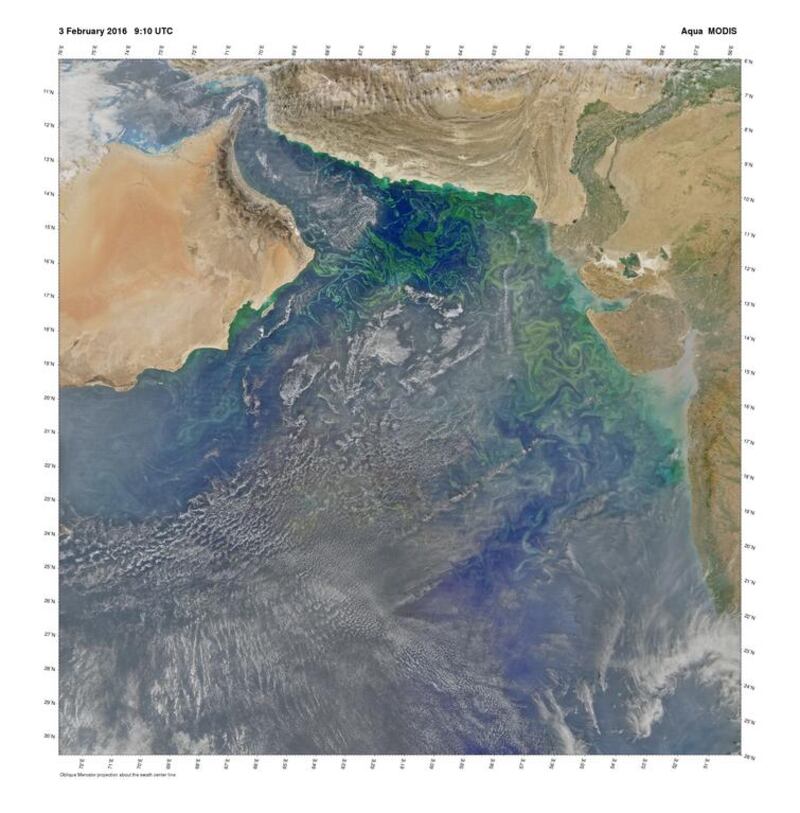FUJAIRAH // A harmful algal bloom is making its way to the shores of Oman and raising questions about consequences for tourism, fisheries and marine ecosystems on the east coast of the UAE.
Reports from Oman this month described a patch of algae-infested water the size of Mexico spreading across the Arabian Sea.
The bloom is caused by Noctiluca scintillans, a common algal species, which is not harmful in small concentrations. Given certain conditions, however, the algae start growing rapidly, reaching dangerous concentrations and forming what is commonly known as a bloom.
Dr Maryam Al Shehhi, a research assistant at the Masdar Institute of Science and Technology, said satellite images showed the first batches of algae-infested water, visible in the eastern part of the Arabian Sea from mid-February.
“The growth and expansion of these algal batches has increased where these blooms are now covering the central Arabian Sea and the Sea of Oman,” she said.
A map compiled by Dr Al Shehhi on Wednesday showed high concentrations of chlorophyll A. This pigment is essential for photosynthesis and is used as a measure of productivity in the oceans. The map shows “high chlorophyll A values” of 10 milligrams per cubic metre over most of the Sea of Oman.
“High concentration of chlorophyll A reflects the high density of the algal species in the water and can cause oxygen depletion,” she said.
The map shows that the UAE waters are relatively unaffected so far. This was confirmed by scuba diving instructor Jeffrey Catanjal.
This month, he said, he only remembered one instance two weeks ago when he dived in “very green” water off Dibba Rock on the east coast. The algae were so thick that visibility in the water was 1 metre, he said.
“Now it is amazing,” he said. “I was diving yesterday and it was good – seven metres’ visibility and sharks are still there, turtles are there. There is no problem.”
Still, it is too early to breathe sighs of relief, said John Burt, an associate professor at New York University Abu Dhabi and head of the university’s marine biology laboratory.
"Because the coastline of Fujairah sits within the wider Sea of Oman, Noctiluca blooms do pose a threat to the UAE," he said.
In high density, algal blooms can clog the intake pipes and membrane filters of desalination plants, threatening to shut them down, he said. Another negative consequence could be mass losses of fish, coral and other marine organisms.
“Such impacts to infrastructure and ecosystems have happened in the recent past,” said Mr Burt.
“A large scale bloom of a different algal species last occurred in 2008-2009 in Fujairah and resulted in the closure of desalination plants, declines in tourist visits to beach hotels, and long-term impacts to coral reefs and fish, with some reefs losing over 90 per cent of their coral.”
The blooms have natural causes, such as rainfall that creates the welling up of nutrient-rich water from the sea bottom and dust storms bringing nutrients in the form of phosphate and iron particles.
Human activities such as aquaculture and the discharge of water from sewage treatment plants also play a role.
“While large-scale weather patterns are out of our control, there are actions that decision-makers can take to limit stressors that might exacerbate conditions leading to blooms,” said Dr Burt.
“That means carefully controlling where and how many aquaculture facilities are in operation, and spending funds to improve sewage treatment infrastructure so that tertiary treatment of the wastewater is done to chemically remove excess nutrients before it is discharged into the sea,” he said.
Dr Al Shehhi said satellite images could help to monitor the UAE’s coastlines by providing real-time data on the location and movement of blooms.
“The real-time satellite images could be combined with hydrodynamic models and meteorological data to build up a forecasting system that can work as an early warning tool to detect and track the movements of the algal blooms,” she said.
newsdesk@thenational.ae
* This story has been updated to correct the unit of measurement for chlorophyll A concentrations.





